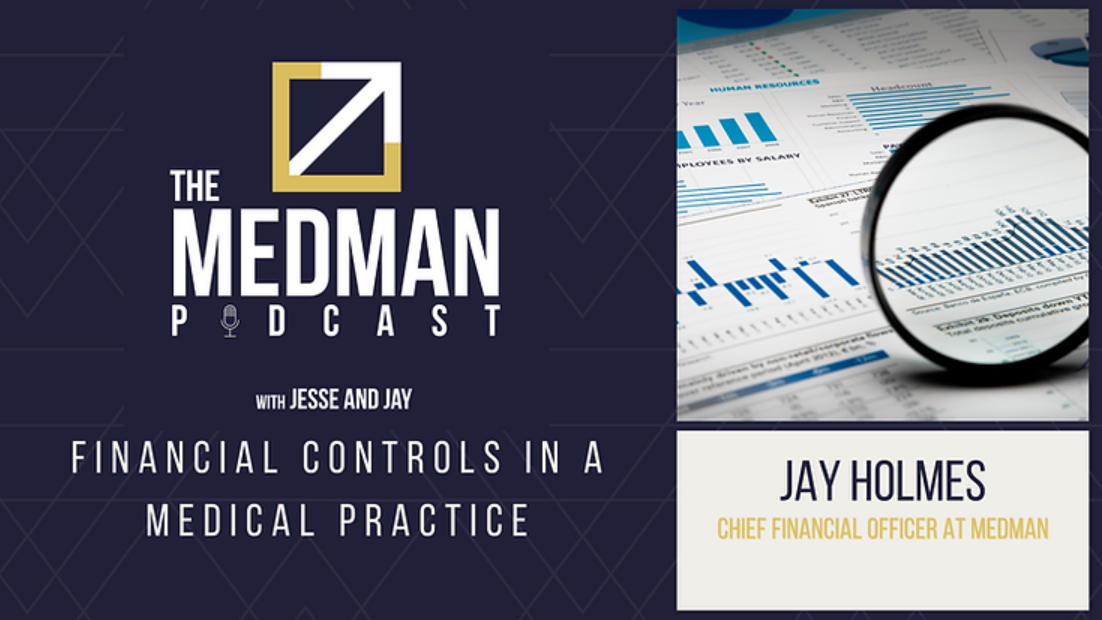
The MedMan Podcast_Financial Controls for A Medical Practice: Audio automatically transcribed by Sonix
The MedMan Podcast_Financial Controls for A Medical Practice: this mp3 audio file was automatically transcribed by Sonix with the best speech-to-text algorithms. This transcript may contain errors.
Jesse Arnoldson:
Welcome to The MedMan Podcast. A podcast focused on helping you level up your practice. I'm Jesse Arnoldson.
Jay Holmes:
And I'm Jay Holmes. Through interviews with some of the most successful leaders in the industry, we help uncover resources, tools, and ideas to help you level up.
Jesse Arnoldson:
Thanks for tuning in and we hope you enjoy today's program.
Jesse Arnoldson:
Hello, everybody, and welcome to the MedMan podcast. We're excited to welcome Jay Holmes back and we're going to be talking about financial controls this time. Last episode, Jay spoke to us about month-end close and why it's important to have in place to make sure that we know that we're operating with a full deck, this time with financial controls, Jay, I'm going to let you take it from here. Explain to us, why are financial controls so important? And maybe give us a couple of examples of what they might be.
Jay Holmes:
Jesse, you bet, man! And again, good to be here. Good to be talking about financial controls. You know, how I look at it controls in general, controls and processes, the stronger they are, the less energy we need for oversight, less frequent we need to do things, right. And I think that's the whole point is if we can really build a system that we can trust because we have the proper steps, proper steps are followed, then the more understood then there needs to be less management of the process. And by all means, doesn't mean that financial controls are set it and forget it. That's not necessarily what I'm saying here. But we can ensure a better level of confidence in what we do if our controls are consistent and put together well. And so when we think about that and financial controls, it's really about how can we ensure, one, that everything is protected. Our assets are, you know, there's no leakage, there's no waste. There's no and really what we're talking about is fraud and embezzlement and things like that. And that's one part of it. Another part is, are we getting the consistency in reporting and understanding of what's really going on. And so financial controls really help both of those sides. One is, think about financial controls, you think about those patient receipts getting written off and putting the front desk person's pocket. Well, that's part of it. But also it's part of that, you think about that the other side of it is that, it's a reporting accurate of inputs coming in and you really generate quality data coming out. So really two sides that financial controls
Jesse Arnoldson:
That make sense. You know, you touched on embezzlement, fraud. What kind of fraud and embezzlement happens out there? Do you have any statistics on that as far as medical practices go?
Jay Holmes:
Jesse, this is a really touchy subject. And unfortunately, you know, stats are 50, 60 percent of practice's experience, some type of fraud or embezzlement. And I think it just depends on the study or whatever you're looking at. But that's one hundred to two hundred thousand dollars a pop that go unnoticed over time. And this isn't one check that's written or won some cash. It's pulled out. I mean, we're talking about years here that build up then to finally notice it. And it's a challenge. And we can talk about this later, but it's really a challenge to detect it if you don't have the proper controls set up because it's about trust. And if you're leaning on someone that ultimately is doing something like this, you have the trust in them in the course, they're never going to be outright say this is what I'm doing. So it really creates an odd dynamic. And so you fall back to your controls to hope to at least allow you to identify what's going on.
Jesse Arnoldson:
You know, we always talk about trust in our teams. And I think that there's a perverted understanding of trust sometimes in that you're like, well, no, I, my people wouldn't do that or no, I don't. You know, I don't really want to be looking over their shoulder all the time because I want them to know I trust them. But that's not necessarily trusted. And I think that what they're afraid of is getting to the point of being cynical and they don't trust anybody and they're micromanaging everything. And that's not where you want to be either. But there's a place here where financial controls play a role so that you can trust and you build trust in one another. That's the whole point of putting these kinds of things in place. There can be a perversion on either side of it.
Jay Holmes:
Yeah, absolutely. And I think at some point it's almost a relief, right, like so, I think for most and I think what happens most of the time, right, there's like this and I don't remember ... the time ahead, but there's this kind of triad of things that need to happen for fraud to occur and it's opportunity is one of them. But I think there's this motivation, right, like,
Jesse Arnoldson:
So opportunity, justification and need or something?
Jay Holmes:
I think need. Yeah. Yeah, absolutely. And I think it's need.
Jesse Arnoldson:
And justification is there. Good people do crummy things sometimes because they can figure out in their head how it's OK. That's part of the fraud triangle. Right.
Jay Holmes:
Absolutely, and opportunity, you can always, that's what the controls are working on. Right. So really reduce that opportunity. But people throughout their lives are going to run into hard places, hard situations to work through. And if the opportunity is there, then all of a sudden there's a pathway that creates that. And so you back up and you say, OK, well, sure, you can approach this issue with I'm coming in and I'm going to really not trust anyone to push everyone down. But I don't think that's the right approach. It's really saying,
Jesse Arnoldson:
Yeah, totally.
Jay Holmes:
I want to relieve everybody so they don't have to worry about ever getting looked at like you're doing this or you doing that. Right. You're saying, hey, we're all following these controls so we can remove that more because we have these controls in place. And I think that's an interesting approach and certainly one that leads to more success.
Jesse Arnoldson:
I have personally seen that in my experience of putting a control in place maybe up at the front desk and a receptionist being like, oh, good, because I know it stresses me out that I just have all this cash here and you guys expect that I have it right or not right because I'm always afraid that something's not going to be right and people are going to think I'm doing something shady. That's been a real experience of mine seeing the relief in a receptionist's face when we put something in place like that.
Jay Holmes:
Totally. Yeah.
Jesse Arnoldson:
Can you give me a couple more examples, Jay, of what kind of financial controls you might be talking about?
Jay Holmes:
Certainly one of the kind of bigger categories here is kind of segregation of duties, and that's a lot of embezzlement or fraud when we're looking at that and is really around certain people doing too many things. And so without the oversight or without the cross-pollination of someone else doing it, that creates more opportunity for hiding things. And a lot of that stuff, too, is really it's spread out over time. So separating the duties between different people and even promoting vacation or promoting cross-training and every once in a while putting someone in in a specific role for maybe a month or a couple of weeks, that just shiftings a little bit. Those are the types of things that really bring to light. Well, one that can really highlight certain areas or certain fraudulent activities. But if none are occurring in that type of environment is in place, that's a huge deterrent for people because oftentimes fraud doesn't happen with multiple people. It's usually one-person kind of acting solo. And so when you bring in and you really separate the amount of things that one person can do, that makes a huge difference. So really, we look at the segregation of duties. So you think about the revenue side of things and dollars coming in and out. You think about is someone opening the mail and a different person posting payments to the billing system. And then if someone else deposited into the bank and then you got to look at the write-offs and adjustments and someone else looking at that. And it could be a committee, it could be a team. And then ultimately then someone's reconciling to the bank account. And just those are the types of things we look at from the revenue cycle side that, hey, you know, we need to separate these different duties. And oftentimes smaller practices are challenged because there might be two people that we can choose from. And in those circumstances, what we want to do is we want to bring in the owner. We want to say, hey, the owner needs to have one or two of these roles so we can play a role. Yeah, absolutely. Because that's really the only way to ensure it. And oftentimes what we do is we say, hey, I trust this person enough, I'm going to go give him or her this extra duty or that one. And then all of a sudden one person might have three of those steps, which makes it really easy to manipulate things and a smaller practice, a lot more pressure not to take vacation, there's not much turnover and all of a sudden you've got someone sitting in the seat for five years without much interruption. And that's a dangerous situation as far as because you're building confidence over time when you get to the point where, you know why me, back in the public accounting days, we've ran into this not often but enough. And we got looked at like, how dare you accuse my bookkeeper or my office manager of that?
Speaker3:
Right,
Jay Holmes:
You know, how dare you? Because that's my guy, that's my gal. How could you do that? Come to find out three hundred thousand dollars later that they actually did take that money. But the bond is so strong that it's so hard to see when you're in it. And so you don't want to let you go, want to let your emotions and your relationship get in the way of the transparency and what's going on in your business
Jesse Arnoldson:
That makes total sense. Jay, help me understand, one, where do you start to put financial controls in place? Where do you even begin and to how do you let it not be a runaway train that just creates a lot of extra work?
Jay Holmes:
Good question, because certainly can become a lot of extra work. I always start with process mapping. And so the first thing to do is really map a couple of different functions you have and you really just walk through where someone how different methods that you can get paid, right. Walk through that and map that out. OK, so this person comes in, there's a copay and there's that gets built to insurance and then all these different things and there's adjustment here. Walk through all that and then map it out, who touches it, when and how and really those processes that are involved. And then the same thing with expenses, right, map out that process. How do things get paid? Is it credit card or is it check? Then what you have is, hey, this is what we really have now. And then you can get some help to say or read some stuff. Certainly what's best practice, right? Where should the segregation of duties be? Where should we have this certain threshold? Anything over a thousand bucks or fifteen hundred dollars should require two check signers. Where are the checks kept, how to have access. Does anyone looking at that didn't prepare the financials, is anyone looking at what's being spent just to match it? Do you have a vendor list that's approved? Because that's another big leakage point, is making up a vendor that sounds like something that you usually pay, but it turns out to be an employee's company that they created. Some are bigger fraud schemes out there involve that. So, there's lots of stuff, but really create the map, see where you're on now. And then you can compare that and then you can really analyze that for some gaps. And then, of course, it's you don't have to jump in. The goal is to get better. It's not to get perfect.
Jesse Arnoldson:
Right.
Jay Holmes:
Because you'll never get perfect. So then say, OK, assess where you are and you've got maybe these two, three items that you want to work on to build up strength, build up some strength. You don't have to go head first and do it all. And then over time you can add another section or another initiative. And soon enough you're going to have created a lot more confidence, a lot better controls. And that's the goal, is just to keep it up and finally get to a place where you're feeling pretty good.
Jesse Arnoldson:
Absolutely. That makes total sense. Thank you, Jay. Listeners, financial controls are put in place to either catch fraud at the worst or at best, help your team feel a little bit safer in their positions, feel a little bit better trusted. It's not fair to put anything on somebody on your team that might put them in a place of being accused of doing something wrong. These financial controls are extremely important. And they're not they don't need to be extra work. They don't need to be a ton of micromanagement. Like Jay said, start with a process map. Just sit down and draw out exactly how a simple process goes and start to insert little things in there that can help make sure that things are on the up and up, the biggest of which is the segregation of duties. Getting a couple of extra hands or extra eyes on the process can alleviate any sort of stress that might come from a single person going through it on their own. Jay, thanks again for being here. And this week, sharing your thoughts on monthan clothes and financial controls. We really appreciate it.
Jay Holmes:
Jesse, happy to, and thanks for having me.
Jesse Arnoldson:
And listeners before you get too far, make sure that you hit that subscribe button so you can stay up to date on all the newest content coming from MedMan. And we'll see you next week.
Jay Holmes:
Thanks for tuning in to the MedMan Podcast, we hope you enjoyed today's featured guest.
Jesse Arnoldson:
For the show notes, transcripts, resources and everything else MedMan does to help you level up, be sure to visit us at MedMan.com.
Sonix is the world’s most advanced automated transcription, translation, and subtitling platform. Fast, accurate, and affordable.
Automatically convert your mp3 files to text (txt file), Microsoft Word (docx file), and SubRip Subtitle (srt file) in minutes.
Sonix has many features that you'd love including automated transcription, collaboration tools, share transcripts, world-class support, and easily transcribe your Zoom meetings. Try Sonix for free today.
Episode Summary
-
The stronger the processes the less oversight and energy needed.
-
There are two sides to financial controls: receipt writing and accurate data generation.
-
Financial controls are also about trust in the team.
-
Start the controls by process mapping.
-
Find out more about the Fraud Triangle Theory here: https://corporatefinanceinstitute.com/resources/knowledge/accounting/fraud-triangle/








